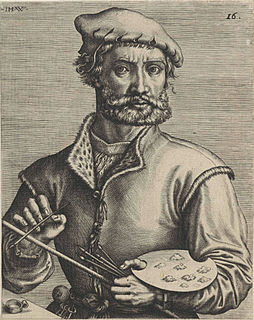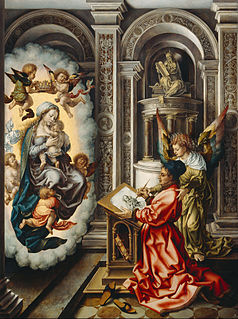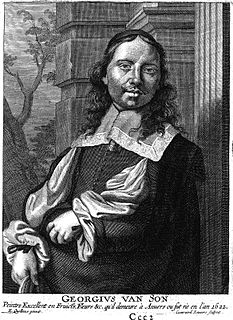
Jan Brueghelthe Elder was a Flemish painter and draughtsman. He was the son of the eminent Flemish Renaissance painter Pieter Bruegel the Elder. A close friend and frequent collaborator with Peter Paul Rubens, the two artists were the leading Flemish painters in the first three decades of the 17th century.
Michiel Coxie the Elder, Michiel Coxcie the Elder or Michiel van Coxcie, Latinised name Coxius, was a Flemish painter of altarpieces and portraits, a draughtsman and a designer of stained-glass windows, tapestries and prints. He worked for patrons in the principal cities of Flanders. He became the court painter to successively Emperor Charles V and King Philip II of Spain.

Pieter Coecke van Aelst or Pieter Coecke van Aelst the Elder was a Flemish painter, sculptor, architect, author and designer of woodcuts, goldsmith's work, stained glass and tapestries. His principal subjects were Christian religious themes. He worked in Antwerp and Brussels and was appointed court painter to Charles V, Holy Roman Emperor.

Romanism is a term used by art historians to refer to painters from the Low Countries who had travelled in the 16th century to Rome. In Rome they had absorbed the influence of leading Italian artists of the period such as Michelangelo and Raphael and his pupils. Upon their return home, these Northern artists created a Renaissance style, which assimilated Italian formal language. The style continued its influence until the early 17th century when it was swept aside by the Baroque.

Juan van der Hamen y (Gómez de) León was a Spanish painter, a master of still life paintings, also called bodegones. Prolific and versatile, he painted allegories, landscapes, and large-scale works for churches and convents. Today he is remembered mostly for his still lifes, a genre he popularized in 1620s Madrid.

Pieter van Avont or Peter van Avont, (1600–1652) was a Flemish painter, draughtsman and printmaker known for his religious scenes and cabinet paintings often including nude children and putti. Van Avont was a frequent collaborator with many leading painters in Antwerp.

Joris van Son or Georg van Son was a Flemish still life painter who worked in a number of sub-genres but is principally known for his fruit still lifes. He also created flower still lifes, banquet still lifes, vanitas still lifes and pronkstillevens. He is known to have painted fish still lifes representing the Four Elements. He collaborated with figure artists on 'garland paintings', which typically represent a devotional image framed by a fruit or flower garland.

Charles Emmanuel Biset or Karel Emmanuel Biset was a Flemish painter who had a peripatetic career working in various cities and countries including his hometown Mechelen, Paris, Annonay, Brussels, Antwerp and Breda. He worked in many genres including genre scenes of interiors with merry companies and gallery paintings, history painting, still life and portraiture.

Pieter Snyers or Peter Snijers was a Flemish art collector, painter, draughtsman and engraver. He practised a wide variety of genres, including portraits, genre painting, still life and landscape painting. His masterpiece is a series of 12 paintings, each representing a different month of the year.

Jan Pauwel Gillemans the Elder was a Flemish goldsmith and still life painter who is known for his fruit still lifes, flower pieces, vanitas still lifes and pronkstillevens.

Jan Pauwel Gillemans the Younger was a Flemish still life painter. He worked in a range of still life genres including flower and fruit still lifes, banquet still lifes, pronkstillevens and hunting pieces. He collaborated with figure painters to create landscapes which combined a mythological or allegorical scene with a still life. He worked and lived in Antwerp, Middelburg, London and Amsterdam.

Nicolaas van Eyck or Nicolaes van Eyck, was a Flemish painter active in Antwerp in the middle of the 17th century. He is known for his equestrian and battle scenes, landscapes and portraits. He also painted a few civil processions, including parades of the Antwerp civil militia.

Gaspar Peeter Verbruggen or Gasparo Pedro Verbruggen was a Flemish still life painter who is principally known for his decorative still lifes with flowers and fruit. He collaborated with figure artists on compositions which combined figures with a still life element. He was active in Antwerp and The Hague.

Peeter Gijsels or Pieter Gijsels, was a Flemish Baroque painter. He is known for his landscapes, architectural compositions and still lifes. His landscapes in the style of Jan Brueghel the Elder were very sought after in his time. He is also regarded as a genre painter as he painted village scenes of village markets and kermises.

Raphael Coxie, was a Flemish Renaissance painter mainly known for his portrait and history paintings.

The Master of the Prodigal Son, was the notname given to a Flemish painter and designer of tapestries and stained glass. He was active in Antwerp where he operated a large workshop between 1530 and 1560. He painted religious subjects, landscapes, genre scenes and allegories. He is regarded as a leading master of Flemish Mannerism in the sixteenth century.

Jacob van der Kerckhoven, known in Italy as Giacomo da Castello, was a Flemish painter. After training in Antwerp, he was active in the Veneto region in Italy. He was one of the most prominent still life and animal specialists active in the Veneto territory around the turn of the 18th century.

Jan Anthonie Coxie or Anthonie Coxie was a Flemish painter and draughtsman mainly known for his portrait and history paintings. After starting his career in Flanders he moved abroad and worked in Amsterdam, Berlin, Mainz and Milan where he worked for an elite clientele.
Jan Coxie was a Flemish painter and draughtsman mainly known for his landscape paintings. He was a member of the Coxie family of artists which played an important role in the development of Flemish painting in the 16th and 17th centuries.

















